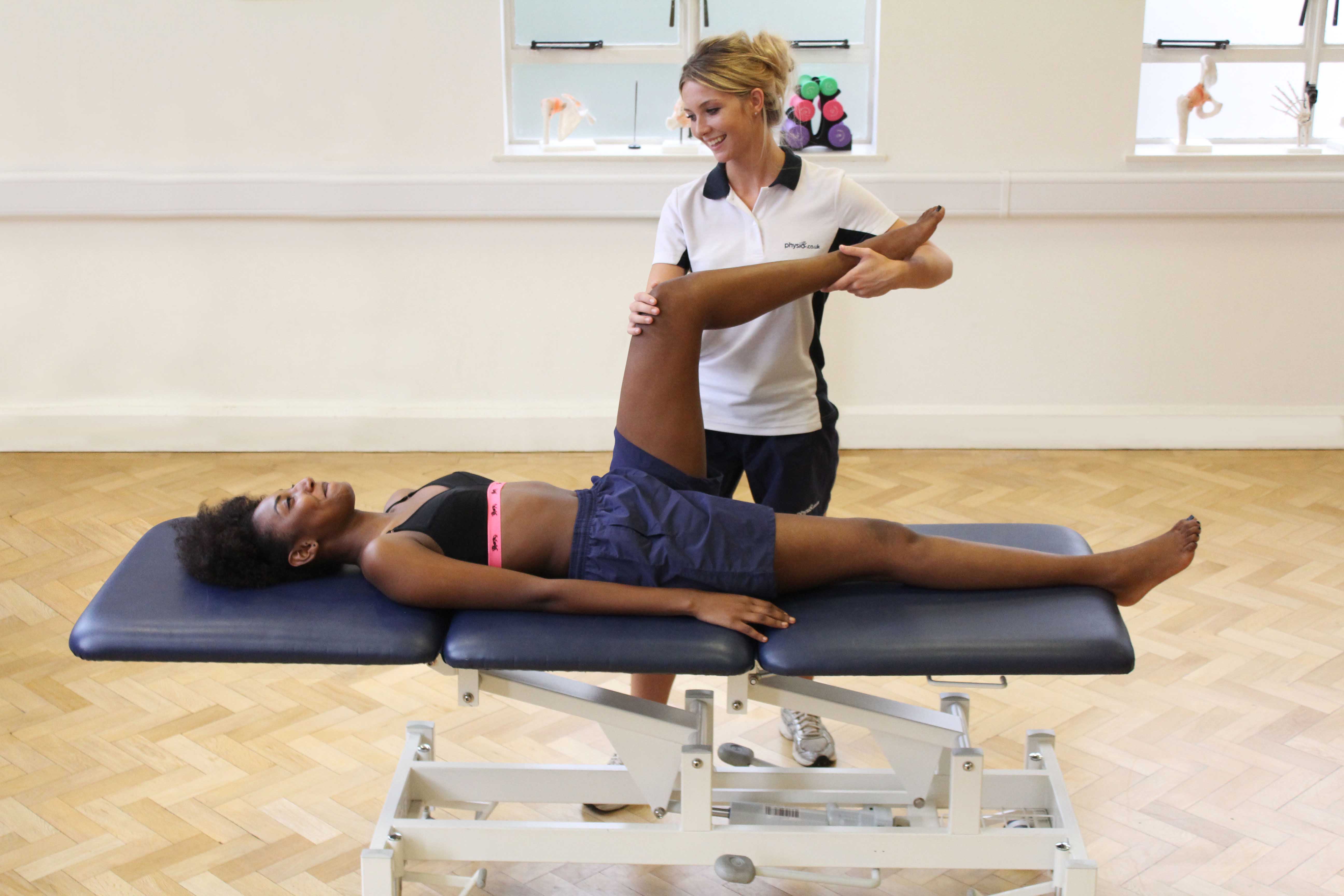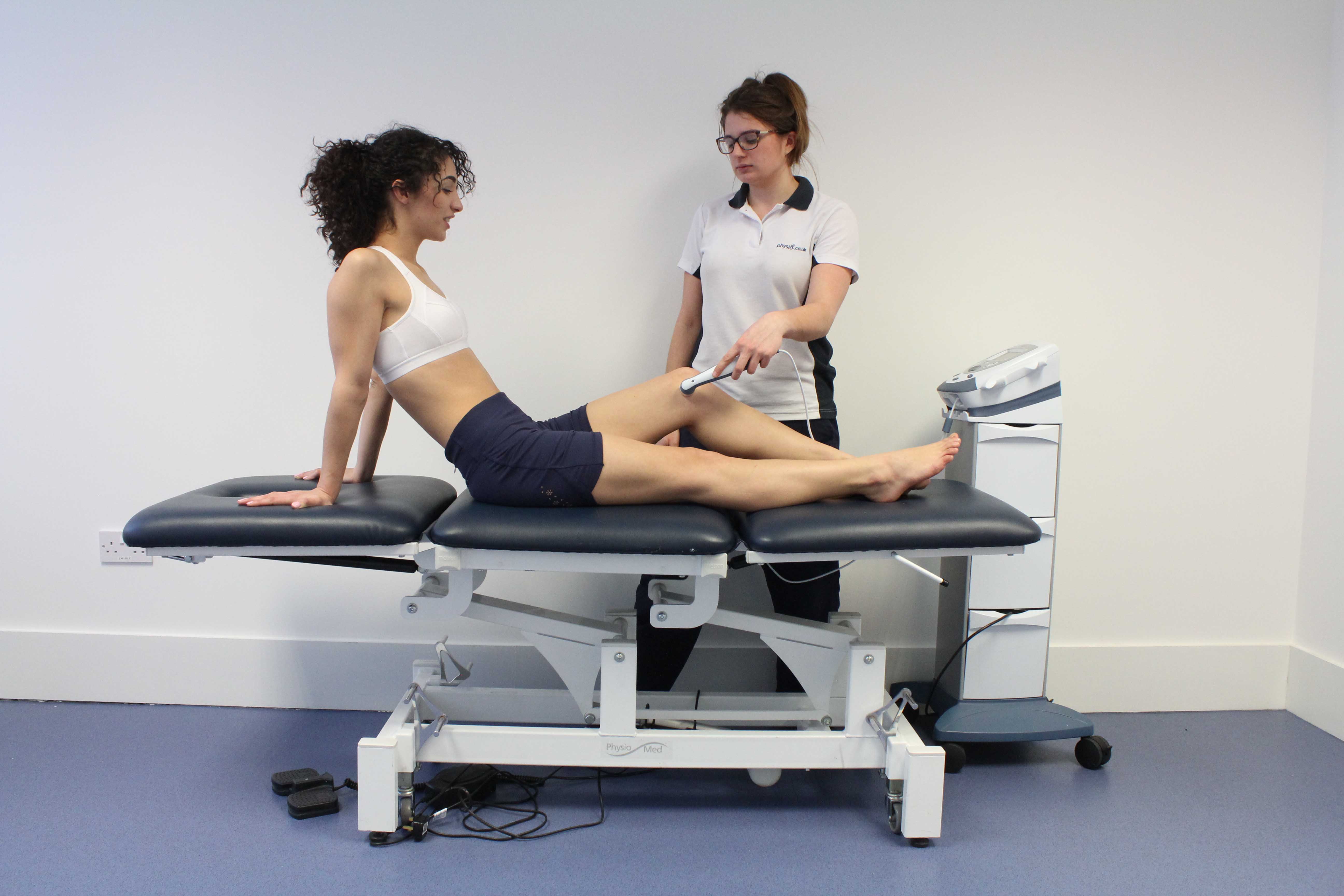Posterior Cruciate Ligament Rupture
The posterior cruciate ligament (PCL) is a strong and large ligament located deep within the knee joint. It arises from the bottom of the femur (thigh bone) and travels downwards and backwards to the tibia (shin bone). The role of the posterior cruciate ligament is to provide the knee with stability. This is done by the ligament preventing the tibia moving too far behind the femur and preventing excessive straightening and twisting movements of the knee joint.
What is a posterior cruciate ligament rupture?
A posterior cruciate ligament rupture is when the ligament completely tears. This happens when the ligament can no longer withstand the forces being applied to it causing it to snap. This results in significant pain in and around the knee cap (patella) and major instability.
 Above: Therapist performing knee assessment
Above: Therapist performing knee assessmentA ruptured posterior cruciate ligament is classified as a grade lll injury which means the ligament is completely torn and the knee becomes unstable.
A posterior cruciate ligament rupture can be either chronic or acute. Chronic injuries develop over time whereas acute injuries happen suddenly.
Diagnosis and treatment for a posterior cruciate ligament rupture is vital otherwise the onset of osteoarthritis is imminent as well asongoing instability.
What causes a posterior cruciateligament rupture?
A posterior cruciate ligament rupture usually occurs when a force is applied to the knee whilst it is flexed (bent). This can commonly be seen in:
- Sporting accidents normally involving football, rugby and skiing – a rupture of the PCLcan occur when the athlete falls to the ground with the leg bent which causes the tibia to hit the ground first.
- Road traffic accidents – a rupture of the PCL can occur when the tibia strikes the dashboard causing the ligament to snap due to too much force being applied backwards.
 Above: Ultrasound applied to the knee by specialist physiotherapist
Above: Ultrasound applied to the knee by specialist physiotherapistWhat symptoms caused by a posterior cruciate ligament rupture can physiotherapy help with?
Physiotherapy can help with the many symptoms that arise due to a ruptured posterior cruciate ligament. They include:
- Severe pain
- Swelling
- Inability to weight bear
- Stiffness
- Decreased strength
- Decreased range of movement
- Instability
- Decreased function
How is a posterior cruciate ligament rupture diagnosed?
A posterior cruciate ligament rupture is diagnosed by the physiotherapist taking a comprehensive subjective and objective assessment. The physiotherapist will confirm the posterior cruciate ligament rupture by carrying out a special test called the posterior drawer test. If the test is positive then the physiotherapist will request an MRI scan to confirm the findings.
An x-ray may also be requested to rule out any fractures as sometimes the posterior cruciate ligament may pull away a part of the bone from its origin or attachment. This type of fracture is known as an avulsion fracture.
Medical treatment
Surgery may be required depending on a number of factors. They are:
- The patient wanting to return to a high level of sport or work were stability of the knee is vital
- Other structures within the knee have also been damaged
- The patient has ongoing knee instability and pain following an intensive physiotherapy programme
Prehabilitation is often stipulated before surgery in order to decrease the swelling and increase the strength and range of movement. This is done to facilitate the rehabilitation following surgery which can as long as 12 months to ensure the patient has the best chance at returning the knee to pre injury level.
Benefits of physiotherapy for a posterior cruciate ligament
There are many benefits to be gained by having physiotherapy treatment following a posterior cruciate ligament rupture. They include:
- Decreased pain
- Decreased swelling
- Increased range of movement
- Increased strength
- Improved balance
- Improved stability
- Gradual return to function and sporting activity
What would physiotherapy treatment for a posterior cruciate ligament rupture involve?
Physiotherapy treatment for a posterior cruciate ligament rupture varies from patient to patient but may generally include:
- Range of movement exercises
- Soft tissue massage
- Bracing
- Electrotherapy
- Education
- Walking aid advice
- Balance exercises
- Sport specific rehabilitation programmes
- Strengthening exercises
- Taping
- Ice or heat treatment
- Anti-inflammatory advice
- Acupuncture
- Hydrotherapy
- Gait re-education
- A gradual return to function
How do I arrange a physiotherapy assessment for a posterior cruciate ligament rupture?
If you have a posterior cruciate ligament rupture and think that you would benefit from seeing one of our experienced physiotherapists then you can either email us at office@..............or call us on 01…………
Summary
The large and strong posterior cruciate ligament plays an important role in keeping the knee stable. If the ligament ruptures then physiotherapy treatment is vital. Surgery may be required depending on the severity of the injury. If left untreated, complications in later life will arise causing instability and a major decrease in function. To receive the correct treatment from a specialist physiotherapist then email us at office@........ Or call us on………………..

 0330 088 7800
0330 088 7800

































